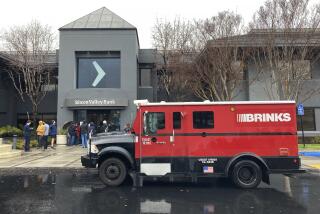Plan to Handle Assets of Failed S&Ls; Unveiled : Proposal Would Bolster Federal Insurance Fund
- Share via
WASHINGTON — The heads of two major trade organizations, outlining proposals for shoring up the federal fund that insures S&L; deposits, Tuesday called for creation of new corporations to handle the assets of failed savings institutions.
Both also told the Senate Banking Committee that federal regulators should require a higher capital net worth for institutions judged to be engaged in risky investment practices rather than requiring them to pay a higher insurance premium into the federal fund.
“Premiums can’t be set high enough to eliminate risk,” said Gerald J. Levy, vice chairman of the U.S. League of Savings Institutions.
The idea for a new corporation to handle problem assets was first proposed in late July by the Federal Savings and Loan Advisory Council, a group of real estate and lending experts that advises S&L; regulators on industry issues.
Among the proposals put forth by officials of both the fund that insures commercial banks and the one that insures thrift institutions is a call for higher cash premiums on members considered to be less conservatively managed.
Same Rate for All
Currently, all federally insured banks and thrifts pay an annual insurance premium of one-twelfth of 1% of their assets--much of which is rebated against the following year’s payment.
The private corporations envisioned to handle the assets already under control of the Federal Savings and Loan Insurance Corp.--the S&L; insurer--would be set up somewhat differently under proposals from Levy’s organization and the National Council of Savings Institutions, headed by Kenneth F. X. Albers.
But the idea would be the same: delegate the FSLIC’s responsibility to manage and dispose of an estimated $2.3 billion in assets--mostly real estate held as collateral for bad loans assumed by the federal agency--to specially chartered organizations that would attract specialists to dispose of the property at the best price.
Money realized from sales would go into the $5.3-billion FSLIC fund held to guarantee deposits.
Both Albers and Levy said the Federal Home Loan Bank Board, which oversees the FSLIC fund, is hamstrung in efforts to properly manage its huge portfolio because it is under personnel constraints of the Office of Management and Budget.
Levy noted that the FSLIC fund has about 25 employees to handle liquidation operations, compared to about 100 for the Federal Deposit Insurance Corp., which insures deposits in about 14,000 commercial banks and is not under personnel constraints.
While it would require legislation to remove the bank board from OMB oversight, creation of a private corporation or corporations chartered by the bank board would not require new laws.
The league’s proposal envisioned one large corporation to handle all of the FSLIC’s holdings, while the council called for 12 separate corporations--one in each of the Federal Home Loan Bank districts.
“We are very, very concerned about a gigantic warehouse to handle all of this,” Albers said. He suggested that a dozen regional operations would do a better job because they would be more familiar with the property that they would be handling.
Bank board officials will say only that they are considering the concept, but Levy said, “My understanding is they are receptive to the idea.”
Since any newly formed corporation or corporations would be under FSLIC supervision, the effect of such a plan would be to shift from a public agency to a quasi-public agency the task of managing FSLIC-acquired properties.
In addition to escaping OMB limits on the number of people who could be put to work on the task, Levy said placing the corporation under private day-to-day management would make it easier to attract highly motivated specialists with financial incentives.
He said the people in the market to buy FSLIC-owned properties are aggressive bargainers, and “we need the same breed of cat.”
More to Read
Inside the business of entertainment
The Wide Shot brings you news, analysis and insights on everything from streaming wars to production — and what it all means for the future.
You may occasionally receive promotional content from the Los Angeles Times.










